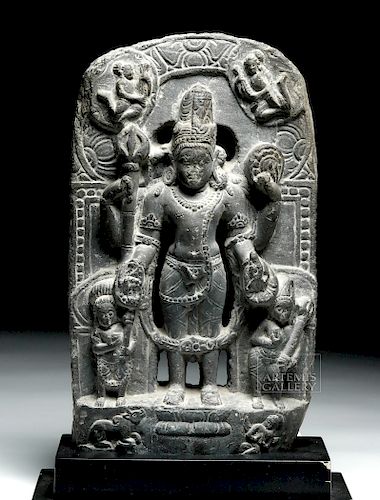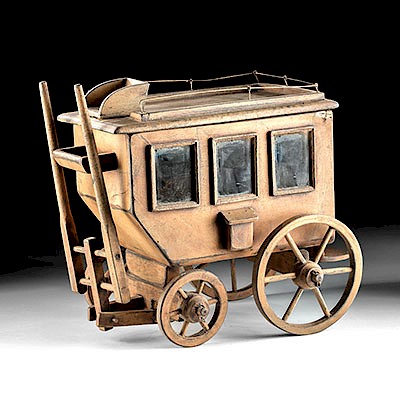Indian Pala Empire Black Schist Carving of Vishnu
Lot 200d
About Seller
Artemis Gallery
686 S Taylor Ave, Ste 106
Louisville, CO 80027
United States
Selling antiquities, ancient and ethnographic art online since 1993, Artemis Gallery specializes in Classical Antiquities (Egyptian, Greek, Roman, Near Eastern), Asian, Pre-Columbian, African / Tribal / Oceanographic art. Our extensive inventory includes pottery, stone, metal, wood, glass and textil...Read more
Categories
Estimate:
$6,500 - $9,750
Absentee vs Live bid
Two ways to bid:
- Leave a max absentee bid and the platform will bid on your behalf up to your maximum bid during the live auction.
- Bid live during the auction and your bids will be submitted real-time to the auctioneer.
Bid Increments
| Price | Bid Increment |
|---|---|
| $0 | $25 |
| $300 | $50 |
| $1,000 | $100 |
| $2,000 | $250 |
| $5,000 | $500 |
| $10,000 | $1,000 |
| $20,000 | $2,500 |
| $50,000 | $5,000 |
| $100,000 | $10,000 |
| $200,000 | $20,000 |
About Auction
By Artemis Gallery
Nov 14, 2019
Set Reminder
2019-11-14 10:00:00
2019-11-14 10:00:00
America/New_York
Bidsquare
Bidsquare : Ethnographic | Tribal | American Frontier
https://www.bidsquare.com/auctions/artemis-gallery/ethnographic-tribal-american-frontier-4634
Featuring Pre-Columbian, Tribal / Oceanic, Spanish Colonial, historical examples from the Spanish, Mexican, and American frontiers, fossils, and more. All items offered for sale have been legally acquired, are legal to sell and are guaranteed to be as described or your money back. Artemis Gallery info@artemisgallery.com
Featuring Pre-Columbian, Tribal / Oceanic, Spanish Colonial, historical examples from the Spanish, Mexican, and American frontiers, fossils, and more. All items offered for sale have been legally acquired, are legal to sell and are guaranteed to be as described or your money back. Artemis Gallery info@artemisgallery.com
- Lot Description
Central Asia, India, region of Bengal, Pala Empire, ca. 8th to 12th centuries CE. A black chlorite schist panel carved with a high-relief, openwork devotional image of the god Vishnu. He wears his characteristic conical hat, a skirt, and rich ornament. He stands flanked by two attendants: his consort and goddess in her own right Lakshmi, who holds a fly whisk, and Sarasvati, goddess of arts and learning, who plays a stringed musical instrument. To indicate his divine status, he stands atop a lotus, with each of his four hands holding an item or doing something of importance: his sacred weapons, the mace and the discus, a conch shell representing the power of creation, and one hand palm out in a gesture of charity. Above him are two further attendants who are each playing stringed instruments, while below him is his sacred mount, Rama the ox, and another partial human figure whose identity is obscured by ancient loss. Size: 8.5" W x 14.3" H (21.6 cm x 36.3 cm); 16.3" H (41.4 cm) on included custom stand.
Vishnu is a blue-skinned, four-armed deity central to Hinduism: the protector and preserver of the world to Brahma's creator and Shiva's destroyer. Temples in Pala were built of brick, with carved stone images like this one set into wall niches. The Pala Empire was the last major Buddhist power in India, although their sculptural art, as here, often includes Hindu elements and iconography. They are well known for their sculpture, which was influenced by the Gupta period, and in turn influenced artwork in Tibet, Nepal, and Southeast Asia.
See a similar example from the National Gallery of Australia: https://artsandculture.google.com/asset/vishnu-with-attendants/gAFxVOgm5smoEA
Provenance: ex-private San Francisco, California, USA collection
All items legal to buy/sell under U.S. Statute covering cultural patrimony Code 2600, CHAPTER 14, and are guaranteed to be as described or your money back.
A Certificate of Authenticity will accompany all winning bids.
We ship worldwide and handle all shipping in-house for your convenience.
#144309Weathering and losses on surface commensurate with age. The most notable loss is from the lower corner. Deposits in lower profile areas.Condition
- Shipping Info
-
All shipping is handled in-house for your convenience. Your invoice from Artemis Gallery will include shipping calculation instructions. If in doubt, please inquire BEFORE bidding for estimated shipping costs for individual items.
-
- Buyer's Premium



 EUR
EUR CAD
CAD AUD
AUD GBP
GBP MXN
MXN HKD
HKD CNY
CNY MYR
MYR SEK
SEK SGD
SGD CHF
CHF THB
THB














